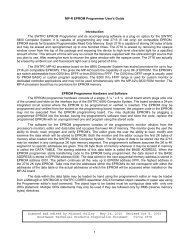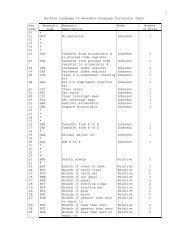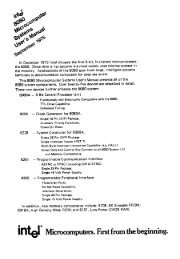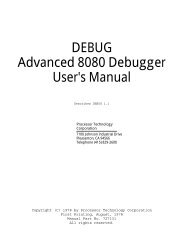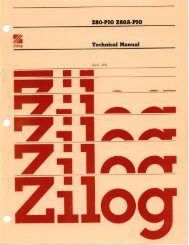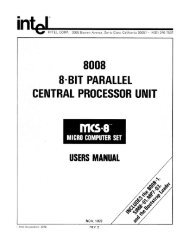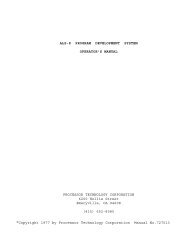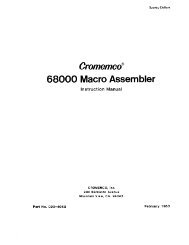The System Manual of SOL-20 - History of Computers
The System Manual of SOL-20 - History of Computers
The System Manual of SOL-20 - History of Computers
You also want an ePaper? Increase the reach of your titles
YUMPU automatically turns print PDFs into web optimized ePapers that Google loves.
PROCESSOR TECHNOLOGY CORPORATION<br />
Sol THEORY OF OPERATION<br />
SECTION VIII<br />
8.1 INTRODUCTION<br />
This section concerns itself with the hardware aspects <strong>of</strong> the<br />
Sol Terminal Computer T.M. . It specifically deals with the operation <strong>of</strong><br />
the power supply and the logic associated with the Sol-PC and keyboard.<br />
Descriptions <strong>of</strong> s<strong>of</strong>tware and the operation <strong>of</strong> the circuitry<br />
contained in the multitude <strong>of</strong> integrated circuits (IC's) used in the<br />
Sol fall outside the scope <strong>of</strong> this section. In some cases, references<br />
to other publications or sections in this manual are provided when it<br />
is felt that additional information will contribute to a better understanding<br />
<strong>of</strong> how Sol operates. Should the reader wish to delve<br />
further into the operation <strong>of</strong> a specific IC, we suggest that he study<br />
the appropriate data sheet for that IC.<br />
<strong>The</strong> section begins with an overview <strong>of</strong> the Sol design. A<br />
block diagram analysis then provides the reader with an understanding<br />
<strong>of</strong> the relationship between the functional elements <strong>of</strong> the Sol-PC.<br />
This analysis sets the stage for detailed descriptions <strong>of</strong> the circuitry<br />
that makes up these elements. <strong>The</strong> section concludes with a<br />
block diagram analysis and circuit description <strong>of</strong> the keyboard.<br />
8.2 OVERVIEW<br />
<strong>The</strong> Sol Terminal Computer T.M. as the name implies, is both a<br />
terminal and computer. It is designed around the S-100 bus structure<br />
used in other 8080 microprocessor-based computers and incorporates<br />
all <strong>of</strong> the circuitry needed to perform either function. In essence,<br />
Sol combines a central processor unit (CPU) with several S-100 peripheral<br />
modules--memory, keyboard input interface (including the keyboard),<br />
video display output interface plus audio cassette tape,<br />
parallel, and serial input/output (I/O) interfaces. Sol-<strong>20</strong> also includes<br />
a five-slot backplane board for adding other memory and I/O<br />
modules that are compatible with the S-100 bus.<br />
An 8080 microprocessor (the CPU) is the "brain" <strong>of</strong> the Sol.<br />
It controls the functions performed by the other system components,<br />
obtains (fetches) instructions stored in memory (the program), accepts<br />
(inputs) data, manipulates (processes) data according to the<br />
instructions and communicates (outputs) the results to the outside<br />
world through an output port. (For information on 8080 operation,<br />
refer to the "Intel® 8080 Microcomputer <strong>System</strong>s User's <strong>Manual</strong>.")<br />
As shown in the Sol Simplified Block Diagram on Page X-24 in<br />
Section X, data and control signals travel between the CPU and the<br />
rest <strong>of</strong> the Sol over three buses: 1) a 16-line Address Bus, 2) an<br />
eight-line Bidirectional Data Bus, and 3) a 28-line Control Bus which<br />
is interfaced to the CPU with support logic circuitry. (Note that<br />
the use <strong>of</strong> a bidirectional data bus permits eight lines to do the<br />
work <strong>of</strong> 16, eight input and eight output.) <strong>The</strong>se three buses account<br />
for the bulk <strong>of</strong> the S-100 Bus which connects the Sol to expansion<br />
memory and I/O modules.<br />
VIII-1



